Barolo and Barbaresco are among the few Italian red wines with a tradition of long ageing lasting longer than 20 to 30 years. Yet it is little known that even these wines, praised today for their majestic appearance, power, depth and complexity, were predominantly sweet and sparkling vintages around 100 years ago. It was not until the end of the 19th century that dry still wine began to establish itself in the area. But even after that, Barolo and Barbaresco remained wines for a small circle of connoisseurs and enthusiasts for decades. The immense tannin of Nebbiolo, from which both wines must be pressed 100 per cent, was then too much for most wine lovers. Those who were familiar with Bordeaux and Burgundy often found Barbaresco and even more so the massive Barolo too rustic for the more refined palate.
In the process, the enormous aromatic potential of Nebbiolo was often overlooked. The tannin of a good Barolo or Barbaresco was by no means peasant and drying, but even then had a highly racy, mouth-watering and precisely not drying astringency. Whoever embarks on the adventure and approaches the wines with an open mind will experience a unique combination of power and fullness with very firm, racy tannins and an acid bite that is rather unusual for wines of this weight class. After an initially somewhat unwieldy and unusual start, the palate will experience an almost explosive development of aromas that cannot be experienced with any other wine and that continues far into the finish.
This is true today, but it was also true decades ago, as can still be demonstrated with well-aged old Barolo. It is amazing how fresh some of the best wines from, say, the 1950s still are today. But it was only with a new generation of Piedmontese winemakers that the Nebbiolo wines of Piedmont began to attract the attention of a wider public around the mid-1980s. Pioneers like Elio Altare or Angelo Gaja turned away from the traditional ageing with long maceration and maturation in large wooden barrels, shortened the skin contact and started to age their wines in new barriques. The wines produced in this way, with their vanilla-sweet and toasty wood aromas and tamed tannins, now also appealed to Bordeaux drinkers and received top marks from the predominantly Anglo-Saxon and, more recently, American wine critics.
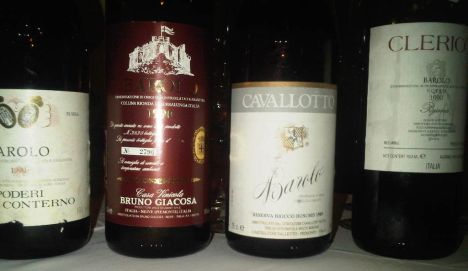 |
| (Source: Elena Altare) |
Nevertheless, the so-called "modernists" had to put up with harsh criticism from traditionally working colleagues and followers of the "pure doctrine" among Nebbiolo enthusiasts. Even the best wines (whose quality was not in doubt) were homeless and denied their origin, they said. In fact, in the first few years, many wines seemed as if the unique character of their variety and origin had been completely sacrificed to wood. Some Barolo could never integrate the wood, decayed long before its time. Instead of racy, mouth-watering Nebbiolo tannin, many newfangled Barolos had brittle, drying wood tannin, which at the time was often still considered a sign of special storability. Only with time did it become clear that a brittle, overly woody wine almost always remains brittle and woody and loses its fruit rather than its unattractive woodiness.
But the modernists also learned. Soon, wines emerged that seemed deceptively modern, polished and sweetly woody in their youth, but over the years the classic Barolo or Barbaresco reasserted itself with its aromatic diversity, its bite and its racy tannins. Today, the best wines of this style turn out to be exceptionally capable of developing and ageing; many of them seem incredibly fresh and lively even after more than 20 years.
The traditionalists among the Barolo and Barbaresco producers, however much they may have positioned themselves against the modernists, not only benefited from the increased attention to the wines of their regions. The pioneers also brought with them a know-how that led to a true quality revolution in the whole area. From then on, the traditionalists also worked more cleanly and precisely. As the modernists perfected their vinification, the traditionally produced Barolo and Barbaresco also gained in purity, finesse and substance.
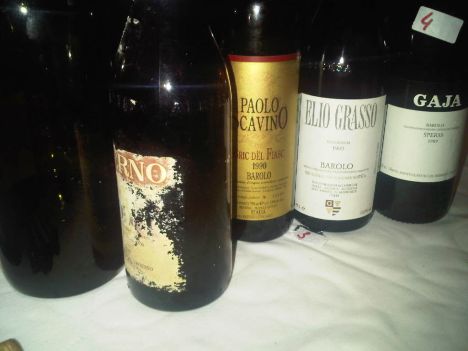 |
| (Source: Elena Altare) |
Today it is impossible to say that one camp produces better wine than the other, if only because the boundaries between the two are becoming increasingly blurred. While the best modern producers have long since perfected the use of the new wood to such an extent that even in their young wines - similar to the greatest Burgundies - hardly anything of it can be tasted, modern technology has also found its way into the cellars of many tradition-conscious wineries, especially where it is a matter of processing the grapes as gently as possible, i.e. in transport and fermentation. It is hard to imagine that even in the traditionally working cellars better Barolos were ever produced than today. If you want to fully understand the essence of Nebbiolo, you cannot avoid the wines of Bartolo Mascarello, Bruno Giacosa, Giacomo Conterno, Aldo Conterno or Cavallotto. Nevertheless, some of the world's greatest wines also come from the convinced modernists such as Elio Altare, Angelo Gaja, Conterno-Fantino, Domenico Clerico, Paolo Scavino or Roberto Voerzio -- and these are just a few of the most famous names and those who are among the most prominent in their respective styles. Many top producers today bring something from both camps and yet produce unique wines full of character that are among the most exciting the world has to offer in terms of alcoholic beverages.
If you want to get an idea of how Barolo and Barbaresco of the different directions develop over the long haul, you can't avoid tasting wines from the 1989 and 1990 vintages. These were the first major vintages in which both styles were already prominently represented, and they, too, were highly differentiated early on. The tasting, from which the notes below are taken, took place in a small circle at the Basilikum restaurant in Erlangen. The tasting was done with the Gabriel glass.
1989 is considered a classic vintage. It was warm, but not too warm; after a cold, wet spring, which had already diminished hopes of a first-class year, there followed an unusually even development into a dry autumn, in which high temperature fluctuations between day and night (as early as August the thermometer sometimes dropped to ten degrees at night) ensured stable acidity and complex, fresh aromas despite the high ripeness of the grapes. 1990, on the other hand, was a decidedly hot and dry year with early flowering, warm nights and a long, warm autumn. In July and August it was so hot and dry that the ripening of the grapes partially stopped, but the long vegetation period nevertheless allowed a high grape ripeness everywhere. In many places, however, this was at the price of dried grapes and low acidity. The wines of this vintage are much more flattering than those from 1989, often with marmalade, compote and dried fruit aromas. However, the Nebbiolo has so much tannin, acidity and aromatic potential that even in 1990 an abundance of immensely beguiling, juicy and racy wines emerged, which, contrary to some fears, hold up and develop magnificently.
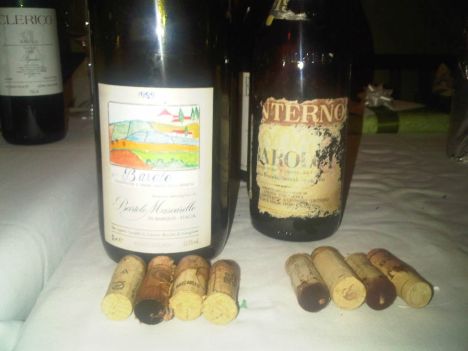 |
| (Source: Elena Altare) |
1990 Barolo Bussia, Aldo Conterno
95 Relatively cool, very fine aroma of tar, wilted leaves, dried red berries and some plums with notes of tobacco, forest floor and herbs, a hint of leather and mineral hints. Very ripe, juicy and also a little marmalade-like red fruit with aromas of dried flowers, fine spicy notes, tobacco and a hint of liquorice, very fine, taut tannin, mouthwatering astringency, quite beguiling aromatics, complex and deep, has elegance and play, long, fine-juicy finish. A classic.
Through 2015+.
1990 Barolo Collina Rionda, Bruno Giacosa
91 Clearly matured nose of red berries, chestnuts and hazelnuts with vegetal aromas, a little reminiscent of cabbage and dried carrots, tobacco, leather, a touch of bacon, undergrowth and a hint of iodine. Also mature in the mouth, aromas of wilted flowers, tobacco, candy and dark caramel, a hint of cocoa, lots of sweet melting and crumbly, fine, very slightly sandy tannin, a little wilted tones on the palate, candied nuts, some alcohol warmth, very slightly melting contours, sweetish-soft, again also alcohol warm finish.
Drinking.
1989 Barolo Vigna San Giuseppe, Cavallotto
96 Present, quite tart aroma of red and some black berries, leather and a hint of cedar wood with aromas of wilted flowers, some preserved plums and tobacco as well as vegetal traces. Very firm and juicy in the mouth, ripe, partly dried fruit, candied nuts, a hint of iodine, herbal malt and old woody tones, fine, tight, mouth watering tannin, lots of power on the palate, excellent depth and persistence, very delicate oxidative tones, lots of tension and bite, complex, becomes even juicier and more beguiling with air, long finish. Great.
Until 2016+.
1990 Barolo Pajana, Domenico Clerico
92 Aroma of soup stock and sauce gingerbread, dried berries, some cherries and plums with notes of foliage, tobacco, malt and earth. Firm, juicy fruit in the mouth, smoky and toasty aromas, candy notes, herbal malt, iodine and dried flowers, sour-sweet juice, some drying tannin, lots of power on the palate, yet has bite and pull, pithy style, lots of autumn leaves and undergrowth, very good to long finish.
Until 2018+.
1989 Barolo, Bartolo Mascarello
96 Relatively cool, yet very firm and complex aroma of leaves and wilted flowers with very fine red berry aromas, some black berries and tobacco, tar and undergrowth as well as earthy minerality. Also cool and very taut in the mouth, concentrated fruit with tart spicy tones, iodine, violets and dried flowers, fine, present, mouth-watering tannin, lively acidity, deep and complex on the palate, notes of candied herbs, minerality in the background, lots of bite and pull, long, taut, juicy finish.
Until 2018+.
1990 Barolo Vigna Chinera, Elio Grasso
94 Distinctly dried-vegetable to tobacco on the nose, woody spice, plus dried and pickled mixed berries and cherries, distinct earthy tones, some iodine and vegetal flavours. Juicy and firm in the mouth, clear fruit, chocolaty, toasty wood flavours, candy, lots of tobacco and some mustard seed, ripe tannin, lots of melting and power on the palate, marmalade-like tones, but also still amazing freshness, candied violets and liquorice in the background, deep and persistent, some warmth, very good to long finish.
Until 2018+.
1989 Barbaresco Santo Stefano Rieserva, Bruno Giacosa
94 Aged, tart, tobacco, somewhat cedary and bacony aroma of red and black berries with notes of wilted leaves, herbs, mustard seed and earthy minerality. Firmly wrought in the mouth as well, ripe, slightly jammy fruit, lots of juice and sweet melting, present, predominantly crumbly tannin, tobacco, candy and caramel, lasting and deep, grippy, herbal notes in the background, mineral, long finish.
Until 2015+.
1990 Barolo Ciabot Mentin Ginestra, Domenico Clerico
93 Lots of soupy spice in the nose, especially lovage, plus malt, tobacco, some tar, earthy-vegetable tones and a little bacon. Ripe, dense and juicy in the mouth, quite dark, partly candied fruit, firm, partly drying but mainly mouthwatering tannin, fine acid bite, powerful and persistent on the palate, candy notes, some cedar and tar, lots of grip, good depth, very good to long finish.
Until 2018+.
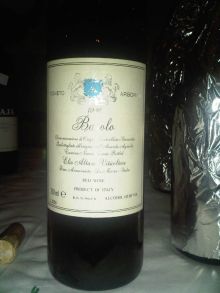 |
| (Source: Elena Altare) |
1989 Barolo Cascina Francia, Giacomo Conterno
97 Deep, complex aroma of preserved, very ripe mixed berries and candied flowers with herbal and mineral notes, some tobacco and tar as well as old woody tones. Firm, dense, deep and extremely juicy in the mouth, taut, concentrated, yet unbelievably fresh fruit in the mouth, candy notes and fine tobacco tones, present, ripe tannin and fine acidity, lots of grip and tension, really vibrates, enormous minerality, candied herbs, still seems amazingly young, deep and very persistent, long, juicy finish. Stunning.
Until 2020+.
1990 Barolo Bric del Fiasc, Paolo Scavino
96 Aroma of preserved mixed berries, lovage, dried herbs, violets, tobacco, mushrooms and earth with delicate oxidative tones and clear minerality. Very firm and immensely juicy in the mouth, delicately oxidative notes, ripe, jammy juicy fruit, very present tannin, some acid bite, distinct earthy minerality on the palate, pithy style, deep and beguiling, flavours of dried flowers, truffles and a hint of mustard seed, complex and long.
Until 2018+.
1990 Barolo Vigna Casa Mate, Elio Grasso
93 Aged, nutty and somewhat vegetal aromas of tobacco, wilted leaves and a hint of iodine with earthy mineral tones. Ripe fruit with tart cedary aromas, earth, some cocoa and nuts, taut, ripe if a touch drying tannins, notes of soup herbs, dried mushrooms, candy and some liquorice on the palate, jammy tones but also fine acid bite, some mustard seed and fennel, mineral tones, good depth, very good, fine juicy and spicy finish.
Until 2017+.
1989 Barolo Sperss, Angelo Gaja
97 Very complex, amazingly fresh, deep, tart, cool and firm bouquet of red and black berries, violets, dried flowers and some liquorice with tobacco and mineral notes. Dense and deep in the mouth, jammy, juicy, incredibly fresh fruit with candy notes and a hint of caramel, very light toasty tones, dried floral aromas on the palate, lots of grip and excellent depth, very animating, long, beguiling finish with salty minerality and highly refined spice. Timeless.
Until 2020+.
1990 Barolo Vigna Arborina, Elio Altare
96 Beguilingly pure, still very fresh, deep, cool and polished aroma of very ripe red and black berries with fine liquorice tones, sweet tobacco and dried flowers. Concentrated, taut and very fresh in the mouth, ripe, rather dark fruit, present, ripe, mouth-watering tannin, very mineral on the palate, deep and persistent, lively despite all concentration, moderate wood spice, fine tobacco notes, clearly modern style, polished, yet deep and complex, beguiling, long, juicy finish.
Until 2020+.
1989 Barolo Monprivato, Giuseppe Mascarello
95 Firm, cool and tart bouquet of red berries, dried flowers and herbs with delicate resinous notes, aromas of dried mushrooms, a hint of liquorice and lovage. Taut and juicy in the mouth, ripe red and black fruit, nutty tones, rock candy, some cedar and dried violets, fine, ripe, present, mouthwatering tannin, lots of bite on the palate, juicy, yet rather tart and pithy, powerful, persistent and deep, peppery tones and a hint of roast, lots of earthy minerality, very good to long, beguiling finish.
Until 2016+.
1990 Barolo La Villa, Seghesio
94 Ripe, tobacco and old woody aroma of ripe, partly dried red and black berries with candy notes and liquorice. Dense, firm and juicy in the mouth, dark fruit with toasty aromas, candy, liquorice and caramel as well as some dark chocolate, very fine, lively tannin, fine acidity, some marmalade tones, but remains taut and juicy, lots of power and excellent depth, a trace of dried mushrooms in the background, long, juicy finish.
Until 2018+.
1990 Barolo Brunate Riserva, Rinaldi
97 Tart, somewhat toasty aroma of very ripe, partly preserved black berries, some sultanas and sweet tobacco with cedary notes, some truffles and minerality. Dense, deep and juicy in the mouth, tightly woven fruit of dried and candied black and red berries, firm, present, gripping tannin, lots of salty minerality, candy notes and fine tobacco flavours on the palate, some coffee, deep, concentrated and complex, long, tight, beguiling finish. Big.
Until 2020+.
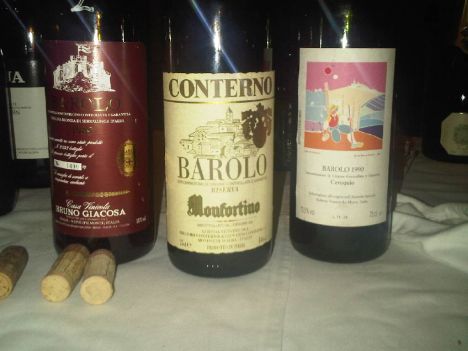 |
| (Source: Elena Altare) |
1989 Barolo Cannubi Boschis, Luciano Sandrone
90 Slightly mature, a little liqueur-like and also a little oxidative aroma of dried red and some black berries with sultana tones, tobacco, dried flowers and earthy hints. Ripe, marmalade-juicy fruit in the mouth, liquorice notes and candied blossoms, fine tannin, melting and power on the palate, minerality in the background, has some bite and some depth, slightly warm style, very good finish.
Until 2015+.
1989 Barbaresco Sori San Lorenzo, Angelo Gaja
94 Soup herbs, tobacco and floral tones in the nose, old and underwoody, earthy and tobacco tones, berry aromas and bacony-mineral hints. Powerful, firm and woody, ripe fruit with candy and some dark chocolate, present, partly still drying tannin, initially tart, but with air more and more juicy, tobacco flavours, candy and a hint of dark caramel, coffee and spices, very slightly oxidative tones, lots of power and grip, a little stewed fruit, deep and persistent, long finish.
Until 2016+.
1990 Barbaresco Sori Tildin Magnum, Angelo Gaja
93+ From a perfectly aged magnum. Strikingly reminiscent of roasted liver, yet very polished nose with aromas of preserved black berries, some red berries and pepper with traces of plums and cherries, chocolate, marzipan, stewed onions, tobacco and wilted flowers. Also quite polished and fresh in the mouth, ripe, firm, juicy fruit, slightly compote notes, some coffee and dark caramel, fine sandy tannin, taut on the palate, rather modern style, juicy, still tremendously youthful, still gaining juice and depth with air, long finish. Needs to mature further, at least in this format.
2015-2025+.
1990 Barbaresco Santo Stefano Riserva, Bruno Giacosa
87 Tart, bacony, developed aroma of red berries with tobacco notes, dry herbs, some smoke and lovage. Sweetly juicy and jammy in the mouth, ripe red fruit, a hint of drying tannin, quite warm and soft style, dried floral aromas and some dried peppers on the palate, very slightly volatile, very good finish.
Drinking.
1989 Barolo Collina Rionda, Bruno Giacosa
96 Clear, fine and deep, quite tobacco aroma of red and black berries with distinct mineral tones and dried floral aromas. Very tightly knit, yet fine, juicy fruit in the mouth, powerful and strong in alcohol, present, taut, mouth-watering tannin, deep and complex on the palate, tobacco, smoky and clearly mineral tones, powerful body with warm, but also cool elements, tightens up with air still, withered-floral aromas, long, multi-layered finish with a lot of pressure.
Until 2016+.
1990 Barolo Cannubi Boschis, Luciano Sandrone
93 Quite complex, tart, acidic aroma of black and red berries with earthy and vegetal aromas, tobacco and earth as well as very slightly volatile notes. Cool, tart and relatively woody in the mouth, again also a trace of volatile, present, slightly rough and drying tannin, herbs, lovage, leather and earth on the palate, minerality, slightly oxidative tones, quite powerful body, concentrated, warm and cool elements, gains juiciness and bite with air, remains in the intrinsically very good to long finish but also a little woody-drying.
Until 2018+.
1990 Barolo Monfortino, Giacomo Conterno
94 Deep scent of candied and dried red and black berries with nutty and slightly vegetal aromas, candy, tobacco, soup herbs and a hint of chocolate. Tart fruit in the mouth, old woody notes, bacon, soup herbs, earth and tobacco, present, very slightly brittle tannin, smoky notes, lots of salty minerality, noticeable alcohol, excellent substance and depth, firm construction, very good to long finish. For all its quality, not the best bottle.
Until 2016+.
1990 Barolo Cerequio, Roberto Voerzio
95 Fine and complex, dense, deep and concentrated aroma of very ripe mixed berries, some plums and wilted leaves with ethereal and mineral tones. Also in the mouth densely woven, concentrated, very ripe fruit, juicy and a hint toasty, present, partly tart tannin, vegetal hints and soup herb notes on the palate, clear minerality, a lot of power and grip, slightly oxidative hints, chocolate and caramel, excellent depth, very good to long, again sweetish-caramel finish.
Until 2018+.